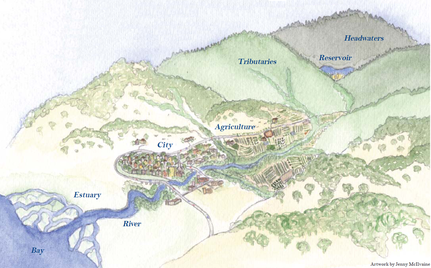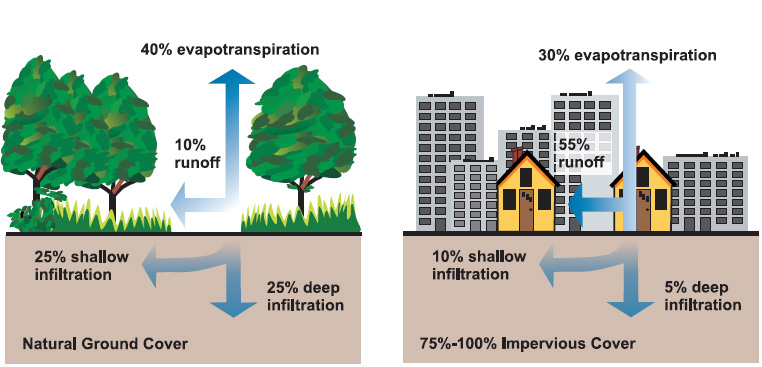What is a Watershed?

Source: www.napawatersheds.org
What is a watershed? A watershed is an area of land that drains to a particular stream, river, or lake. It can also be called a drainage basin or catchment. Watersheds are separated by ridges and hills that are called divides. A watershed consists of surface water--lakes, streams, reservoirs, and wetlands--and all the underlying ground water.
Why is it important? Healthy watersheds are important because they provide habitat for plants and animals, recreational opportunities, drinking water, and aesthetic beauty for our communities.
Why approach clean water efforts via a watershed area? Streams don't know or care about political boundaries. By using the natural boundary of a watershed, issues concerning flooding, stormwater runoff, and water pollution is addressed from within the contributing area.
Why is it important? Healthy watersheds are important because they provide habitat for plants and animals, recreational opportunities, drinking water, and aesthetic beauty for our communities.
Why approach clean water efforts via a watershed area? Streams don't know or care about political boundaries. By using the natural boundary of a watershed, issues concerning flooding, stormwater runoff, and water pollution is addressed from within the contributing area.
The Challenges
1. Parking Lots, Streets, Buildings. Runoff from hard surfaces (often called "impervious" surfaces) pick up pollutants such as oil, gas, salts, and other pollutants and pipes them directly to local streams. Runoff from these impervious surfaces is also collection and routed to stream at a faster rate and volume than in a natural state. With higher volumes of water and higher rates of discharge, flooding and erosion increase. In a natural setting, 50% of water is infiltrated and 10% is runoff. After development, infiltration decreases to 15% and 55% is runoff (see graphic below).

The relationship between impervious cover and surface runoff. Impervious cover in a watershed results in increased surface runoff. As little as 10 percent impervious cover in a watershed can result in stream degradation. (Source: "Protecting Water Quality from Urban Runoff." Document No. EPA 841-F-03-003)
2. Sewage: Failing Septic Systems can contaminate nearby wells and surface waters with bacteria and nutrients. Sewage Overflows are also present in many areas of the watershed. During storms, rainwater flows can infiltrate into the sewer system through illicitly connected roof drains or cross connections and can overload the system. When that happens, untreated sewage is discharged into our waterways. The more stormwater getting into the sewer system, the bigger issue this becomes.
3. Erosion & Stream Instability: As more and more runoff water is routed from impervious surfaces and into the creeks at an unnatural rate, the stream beds begin to erode and the creeks get deeper. When this happens, the banks become unstable and fall in, generally taking whatever property, road, bridge, or utility is nearby with it. This change in flows is called hydromodification and is what happens when too much water is being discharged to the streams at too fast a rate.
4. Missing Riparian Corridor: The riparian corridor is the area of land alongside a stream. Forested riparian corridors helps to slow and filter stormwater runoff, keeps soil from eroding, and provides cooling shade to aquatic species.
5. Pasture Land: Elevated levels of fecal coliform have been found in creeks which run through pastures or livestock use the streams for drinking water.

